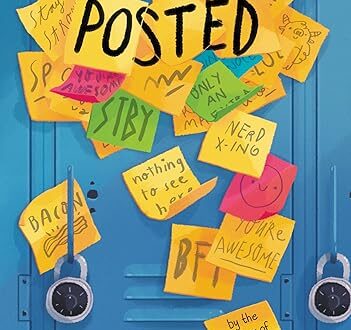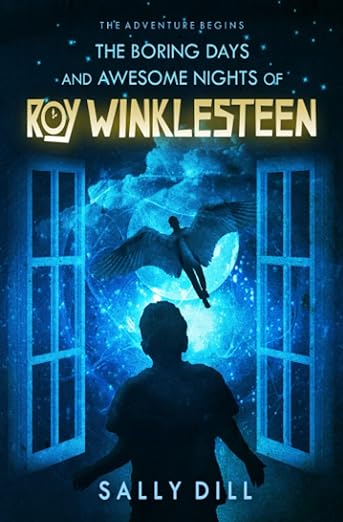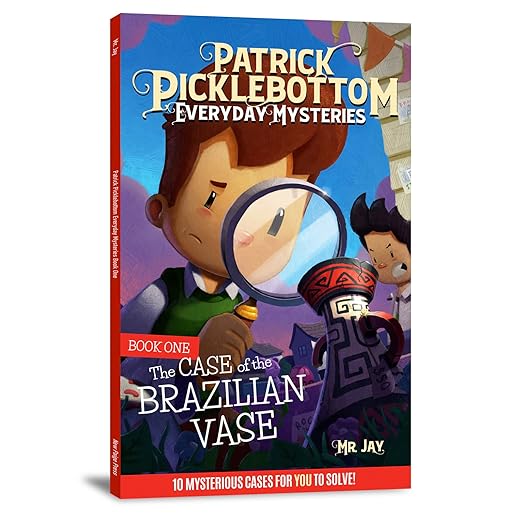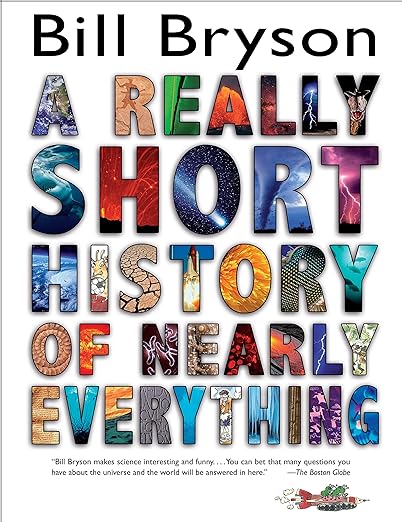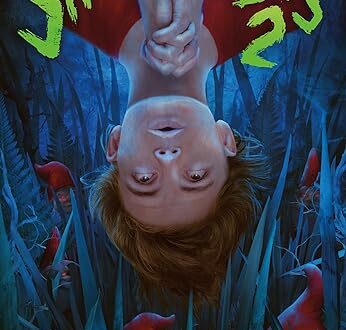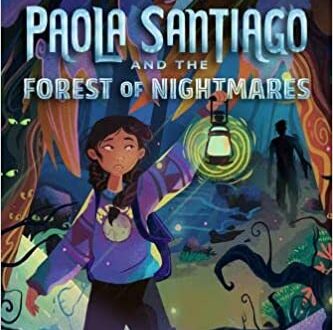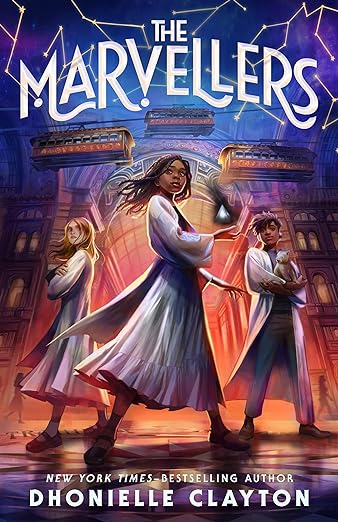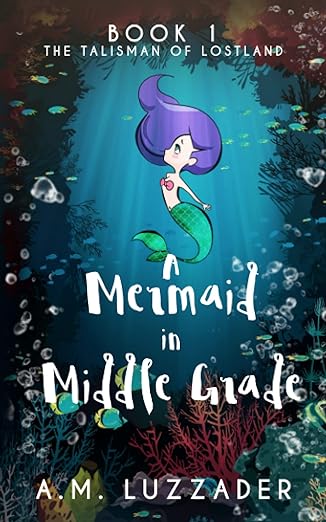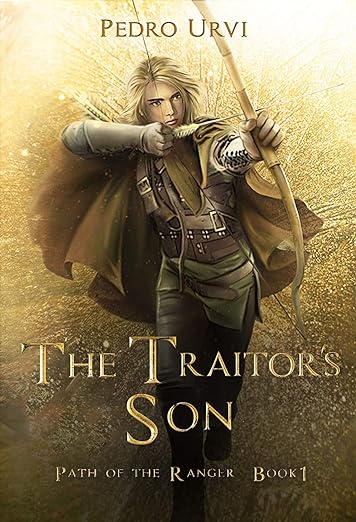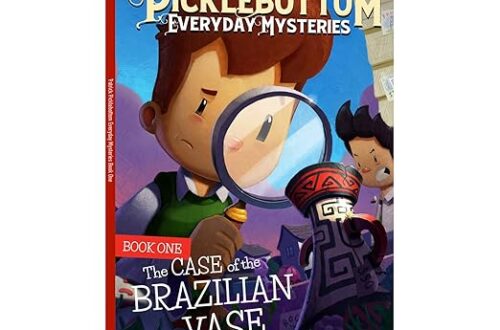-
The Great White Bear (The World’s Deadliest School Trips)
Some school trips can turn out to be deadly dangerous—like this one.
Six young teens visit the Canadian wilderness to view polar bears. They become snowbound in a castle with its terrifying owner, Mr. Lagrave. With escape attempts thwarted, Lance and his schoolmates must find the courage to face Lagrave and the massive polar bear which terrorizes the estate.
This thriller contains references to alcohol and moments of violence which are unsuitable for children under 10. Such activities are brief and not glamorized.
For Readers 10-15 from author Jame DuBern.
-
The Boring Days and Awesome Nights of Roy Winklesteen
According to nightlifer (night owl) Roy Winklesteen, daylifers have no idea what they’re missing. So, when a 2 a.m. glance out his bedroom window reveals a neighbor is hiding a secret of mythic proportions, Roy’s summer break looks a lot more exciting.
Seeking a cure for being the most ignored kid in all of fifth grade, Roy knows an awesome adventure will surely get him noticed in middle school. He watches and waits for the perfect time to move in for a closer look at the mysterious man who lives one street over. Roy’s spy mission doesn’t go as planned. Still, he manages to gain access into his neighbor’s world–where mind-blowing inventions are more common than furniture and fighting crime involves transforming criminals into bumbling fools smothered in questionable goo.
Every night with the neighbor brings Roy one step closer to the most daring adventure of his life. But even if he survives, he can never tell anyone about it.
For Readers 8-12 from author Sally Dill.
-
Patrick Picklebottom Everyday Mysteries: Book One: The Case of the Brazilian Vase
Patrick Picklebottom is out in the neighborhood and on the case – can YOU help him solve 10 different mysteries?
Patrick Picklebottom has a knack for critical thinking. So, it’s not too surprising that he and his best friend, Claire, keep coming across everyday mysteries. In school, at the local ice cream shop, during a history fair – even in his own house – Patrick constantly comes across new cases to crack.
Can you help him solve these confounding mysteries:
- The Case of the Brazilian Artifact
- The Case of the Stolen Bicycle
- The Great Mountain Rescue Mystery
- The Puzzle Behind the New Employee
- The Baking Contest Caper
- The Mystery of the History Fair
- The Case of the Broken Trophy
- The Mystery of the Missing Donut
- Who Shattered the Window?
- The Case of the Acorn and the Oak
Join Patrick and his friends in 10 short stories where YOU help solve the mysteries. Can you figure out the solutions based on the clues provided? Think carefully before checking the answers in the back!
For Readers 8-12 from author Mr. Jay and illustrator Erin Wozniak.
-
A Really Short History of Nearly Everything
Did you know that:
• Every atom in your body has almost certainly passed through several stars and been part of millions of organisms on its way to being you?
• If you are an average-sized kid, you have enough potential energy inside you to explode with the force of several hydrogen bombs?
Plus—What happened to dinosaurs? How big is the universe? Why are oceans salty? Is a meteor going to hit us?
Explore the mysteries of the universe without ever leaving your home! Author Bill Bryson takes on the world of science and answers questions big and small, perfect for curious readers looking to learn outside of the classroom!
For Readers 8-12 from author Bill Bryson.
-
The Presidents Did What?
Step right up for a spooky tour of the White House! A long dead, but still charismatic, Millard Fillmore will serve as your ghostly guide as you make your way through the Executive Mansion.
Learn about the history of each room you visit from ghosts of presidents past-arguably the worst presidents in US history. Discover how they ended up there, cursed for all eternity to haunt the rooms of the White House, and find out why it’s so important for us to learn from their mistakes.
This is a short fun book for Readers 8-12 from author Wag Harrison and illustrator C. Rod Unalt.
-
The Marvellers
Eleven-year-old Ella Durand is the first Conjuror to attend the Arcanum Training Institute, a magic school in the clouds where Marvellers from around the world practice their cultural arts, like brewing Indian spice elixirs and bartering with pesky Irish pixies.
Despite her excitement, Ella discovers that being the first isn’t easy―some Marvellers mistrust her magic, which they deem “bad and unnatural.” But eventually, she finds friends in elixirs teacher, Masterji Thakur, and fellow misfits Brigit, a girl who hates magic, and Jason, a boy with a fondness for magical creatures.
When a dangerous criminal known as the Ace of Anarchy escapes prison, supposedly with a Conjuror’s aid, tensions grow in the Marvellian world and Ella becomes the target of suspicion. Worse, Masterji Thakur mysteriously disappears while away on a research trip. With the help of her friends and her own growing powers, Ella must find a way to clear her family’s name and track down her mentor before it’s too late.
For Readers 9+ from author Dhonielle Clayton and illustrator Khadijah Khatib.
-
A Mermaid in Middle Grade: Book 1: The Talisman of Lostland
A young mermaid. A sea witch out for revenge. Can Brynn Finley become a sea guardian and help humans in danger when she just barely started the sixth grade?
Brynn is the only mermaid in school who hasn’t been able to learn magic. Until she can unlock the secret to magic spells, she can’t become a sea guardian like her parents and friends. On her quest to solve this mystery, Brynn and her best friend encounter a loveable sea turtle, a pair of selkie sisters, and Phaedra, the great and terrible sea witch. But soon Brynn is over her head in trouble. She must learn to ask for help, do her best, and follow the merfolk oath if she wants to become a guardian of the sea!
For Readers 8-12 from author A.M. Luzzader.
-
A First Time for Everything
This middle grade graphic memoir is based on bestselling author and Caldecott Medalist Dan Santat’s awkward middle school years and the trip to Europe that changed his life.
Dan’s always been a good kid. The kind of kid who listens to his teachers, helps his mom with grocery shopping, and stays out of trouble. But being a good kid doesn’t stop him from being bullied and feeling like he’s invisible, which is why Dan has low expectations when his parents send him on a class trip to Europe.
At first, he’s right. He’s stuck with the same girls from his middle school who love to make fun of him, and he doesn’t know why his teacher insisted he come on this trip. But as he travels through France, Germany, Switzerland, and England, a series of first experiences begin to change him―first Fanta, first fondue, first time stealing a bike from German punk rockers… and first love.
Funny, heartwarming, and poignant, A First Time for Everything is a feel-good coming-of-age memoir based on New York Times bestselling author and Caldecott Medal winner Dan Santat’s awkward middle school years. It celebrates a time that is universally challenging for many of us, but also life changing as well.
This wonderful book from award-winning author-illustrator Dan Santat is the winner of the 2023 National Book Award for Young People’s Literature and is for Readers 10-14.
-
Tornadoes—Deadly and Deceptive
Welcome weather watchers and future meteorologists. Today we are going to take a look at one of Mother Nature’s deadliest and most destructive yearly events—tornadoes.
What is a tornado?
Tornadoes are strong, spinning winds that form a column from a cloud to the ground. They look like giant, gray, funnel-shaped clouds. Tornadoes can travel long distances, with some known to travel over 200 miles. The winds of a tornado can reach speeds of up to 480km per hour. Tornadoes can cause great damage, including uprooting trees, overturning cars, and buildings, and lifting roofs and people. Tornadoes come in different shapes and sizes.
Tornadoes are formed when a thunderstorm has a special combination of winds. Inside the storm, there is a rotating column of air that can tilt and touch the ground. This happens when warm, humid air rises and cool air falls in the storm. The speed and direction of the winds can make the air spin faster or slower. Tornadoes are very powerful and dangerous, so it’s important to stay safe when they happen.
Most tornadoes occur in the United States, which averages about 1,200 tornadoes a year. The second country with the most tornadoes is Canada, which has about 100 tornadoes a year. Other countries that have a lot of tornadoes are Argentina, Australia, Brazil, New Zealand, and South Africa. Tornadoes can happen on any continent except Antarctica.
A hurricane cannot turn into a tornado, but it can spawn tornadoes. This happens when the hurricane’s outer rain bands contain strong thunderstorms that create spinning air near the ground. The spinning air can be tilted vertically by the thunderstorm’s updraft and form a tornado. Hurricane-related tornadoes are usually weaker and shorter-lived than those from supercell thunderstorms in the Plains, but they can still be dangerous.
A hurricane and a tornado are different in many ways. Here are some of them:
- A hurricane is a large-scale circulation of multiple thunderstorms that forms over water, with a diameter of hundreds to thousands of miles. A tornado is a small-scale circulation of a single thunderstorm that forms over land, with a diameter of a few hundred feet to a few miles.
- A hurricane can last for days or weeks, while a tornado usually lasts for a few minutes.
- A hurricane has lower wind speed than a tornado but can cause more damage and deaths over a larger area. A tornado has higher wind speed than a hurricane but can cause more localized damage and deaths.
- A hurricane forms near the equator over warm ocean waters, where the sea-surface temperature exceeds 76°F (26.5°C). A tornado forms in the high wind-shear environment of severe thunderstorms that develop over land.
Tornadoes form inside a thunderstorm when there is a collision between warm, humid air and cold, dry air. The cold air pushes over the warm air, creating an updraft. The updraft can start to spin when it is affected by winds blowing in different directions or speeds at different altitudes. This creates a rotating column of air that the thunderstorm’s updraft can tilt vertically and form a tornado.
To stay safe during a tornado warning, you should follow these steps:
- A tornado warning means a tornado has been spotted or indicated on weather radar. You should take action and move to a safe place immediately and protect yourself from flying debris.
- Immediately go to a safe location such as a safe room, basement, storm cellar or a small interior room on the lowest level of a sturdy building.
- Stay away from windows, doors, and outside walls. Protect yourself by covering your head or neck with your arms and putting materials such as furniture and blankets around or on top of you. This is to protect you from flying debris.
- Keep listening to radio, TV, or other news sources for updates on the tornado situation. Stay in your shelter until the tornado warning is over.
- Do not enter damaged buildings. If the building you are in has been damaged, exit with extreme care and stay out. Look around for things that might fall or dangerous debris. Do not use matches or lighters inside.
- A tornado watch means conditions are favorable for tornadoes to occur. You should be ready to move to a safe place and stay alert for updates on the weather situation.
If you ever find yourself facing a tornado, keep all of our safety tips in mind.
AIME
-
The Traitor’s Son: (Path of the Ranger Book 1)
A kingdom in danger, a great betrayal, a boy seeking to redeem his father’s honor. Will he succeed in exonerating him and saving the realm from an enemy in the shadows before it is too late for the whole North?
By the age of fifteen, Lasgol has endured a hard childhood and lives, cornered and hated, in a small village in the North. He is the son of the traitor, the man who betrayed the kingdom and tried to kill the King. His only companions are the mountains and the snow, ever-present in the region. Yet he refuses to believe that his father is guilty, even though the King himself was a witness to the betrayal.
Lasgol is determined to clear his father’s name and has only one option to do so: the School of Rangers, a secret place where they train the respected and feared defenders of the kingdom’s lands for four years. Going there is insane. Hate and death await him. But as the son of a Ranger, he is entitled to attend.
At the Camp he will find himself involved in political intrigues, disloyalties and fights. He will encounter hatred and fearsome enemies, but also a handful of friends, novices as much out of place as he is himself, determined to do whatever is necessary to pass the first year… without dying in the attempt.
Will Lasgol survive the first year of instruction at the Rangers’ Camp? Will he find out what happened to his father? Will he be able to clear his name?
For Readers 10+ from author Pedro Urvi.

